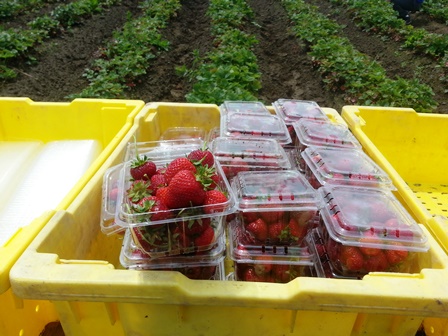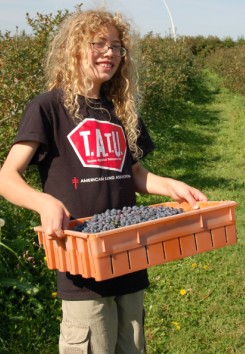Program Image
When trying to establish a new program in a community it is important that the program has a strong and consistent image. This sort of branding helps your audiences recognize the program, and assures them that the program is organized and reliable. Part of this identity should include
-
 Program Name
Program Name
-
Mission statement
-
Catch Phrase
-
Photo/Image
Program Name
The name of your program is very important. It is your first opportunity to convey information about what the program tries to accomplish for your beneficiaries. Whatever name you pick, you should stick with it! When names change it can be confusing. Try brainstorming with friends and work associates to come up with a name. Also, make sure there are no other programs in your area with the same or very similar name.
The name for the gleaning program in Skagit County is Harvest for Hope. After looking at different programs in our area we discovered that there was already a group called the Skagit Gleaners, which gleaned from local food stores and farms. We knew to avoid confusion we did not want to use the word gleaners in our name. Thus we leaned towards harvest instead. We also wanted our name to have a positive tone, so hope seemed liked the right fit.
Mission statement
The mission statement is the purpose of the program. It is important that the statement is as concise as possible. This statement will tell your audience exactly what you are trying to achieve.
Our mission statement is: “Our mission is to increase the supply of fresh, nutritious produce to Skagit County food banks and hot meal programs through harvesting from local farms and gardens.”
Catch Phrase
This is not critical for a program but can be helpful. They are usually short and have a lyrical quality. This statement can often be found with logos. It is usually memorable, and comes to your audiences’ minds when they see the program logo.
The catch phrase for our gleaning program is “Glean it like you mean it!” It is short, and rhymes, and is easy to remember. We were aiming for something upbeat that would get people motivated.
Photo/Image
This can be a logo for the program, or just an image you use with all of your handouts. This makes your program easily recognizable. Further, it is important to choose a color scheme, and stick with it. When you think about all the brands you are familiar with, a certain color and image always comes to mind first. These make a program pop.
Social Media
Social media, such as Facebook, Twitter, blogs, can be a good way to keep stakeholders up to date with your program. However, it is less useful as a recruiting tool. Most growers do not frequently use this type of social media, and it is unlikely that volunteers will stumble across your social media. It is still very important, as it often allows you to show program pictures and tell stories. Use it as a way to keep people interested in your program, or as a reference to those who contact you about getting involved.
Newspapers and Radio
 Press is a very important resources for your program, especially if you are located in a medium to small community. Oftentimes, local newspapers contact information is listed on their website. If you work within another organization, you will want to ask around and find if they already have a specific contact. Also, be aware of the audience of your article, the more targeted information you can provide the reporter, the greater impact of the article. For example, with a magazine specifically targeted towards growers you will want to provide information such as how producers are protected from liability and what their benefits are for participating in a gleaning program.
Press is a very important resources for your program, especially if you are located in a medium to small community. Oftentimes, local newspapers contact information is listed on their website. If you work within another organization, you will want to ask around and find if they already have a specific contact. Also, be aware of the audience of your article, the more targeted information you can provide the reporter, the greater impact of the article. For example, with a magazine specifically targeted towards growers you will want to provide information such as how producers are protected from liability and what their benefits are for participating in a gleaning program.
Websites
Websites are a great tool for spreading information about your program. It is important that your program has one main web address. This will likely connect to the greater website of your organization. Once you have this set up, you can multiply its effectiveness through connections to other sites. Take the time to search the web and find the websites of different agricultural, food, and volunteer groups in your area. Once you have built a strong list contact them and ask them to post information about your program. With a link to your webpage you can limit the text that needs to go on their site, and thus make it less burdensome on the host site. In addition, such cross hosting can improve search engine results for your program and increase visibility.

 Program Name
Program Name Press is a very important resources for your program, especially if you are located in a medium to small community. Oftentimes, local newspapers contact information is listed on their website. If you work within another organization, you will want to ask around and find if they already have a specific contact. Also, be aware of the audience of your article, the more targeted information you can provide the reporter, the greater impact of the article. For example, with a magazine specifically targeted towards growers you will want to provide information such as how producers are protected from liability and what their benefits are for participating in a gleaning program.
Press is a very important resources for your program, especially if you are located in a medium to small community. Oftentimes, local newspapers contact information is listed on their website. If you work within another organization, you will want to ask around and find if they already have a specific contact. Also, be aware of the audience of your article, the more targeted information you can provide the reporter, the greater impact of the article. For example, with a magazine specifically targeted towards growers you will want to provide information such as how producers are protected from liability and what their benefits are for participating in a gleaning program.